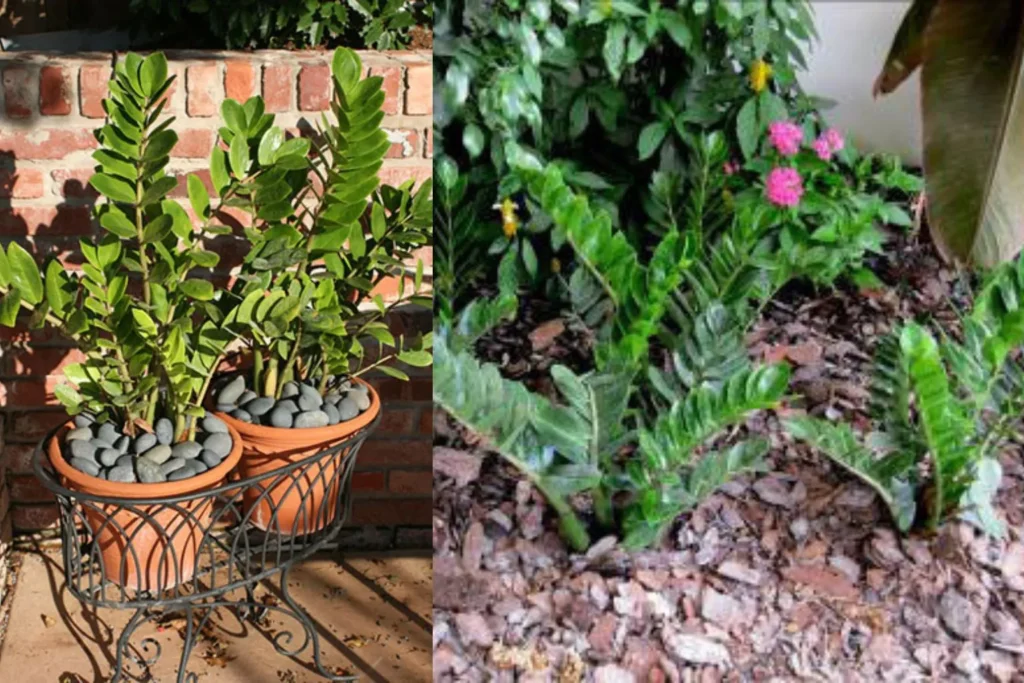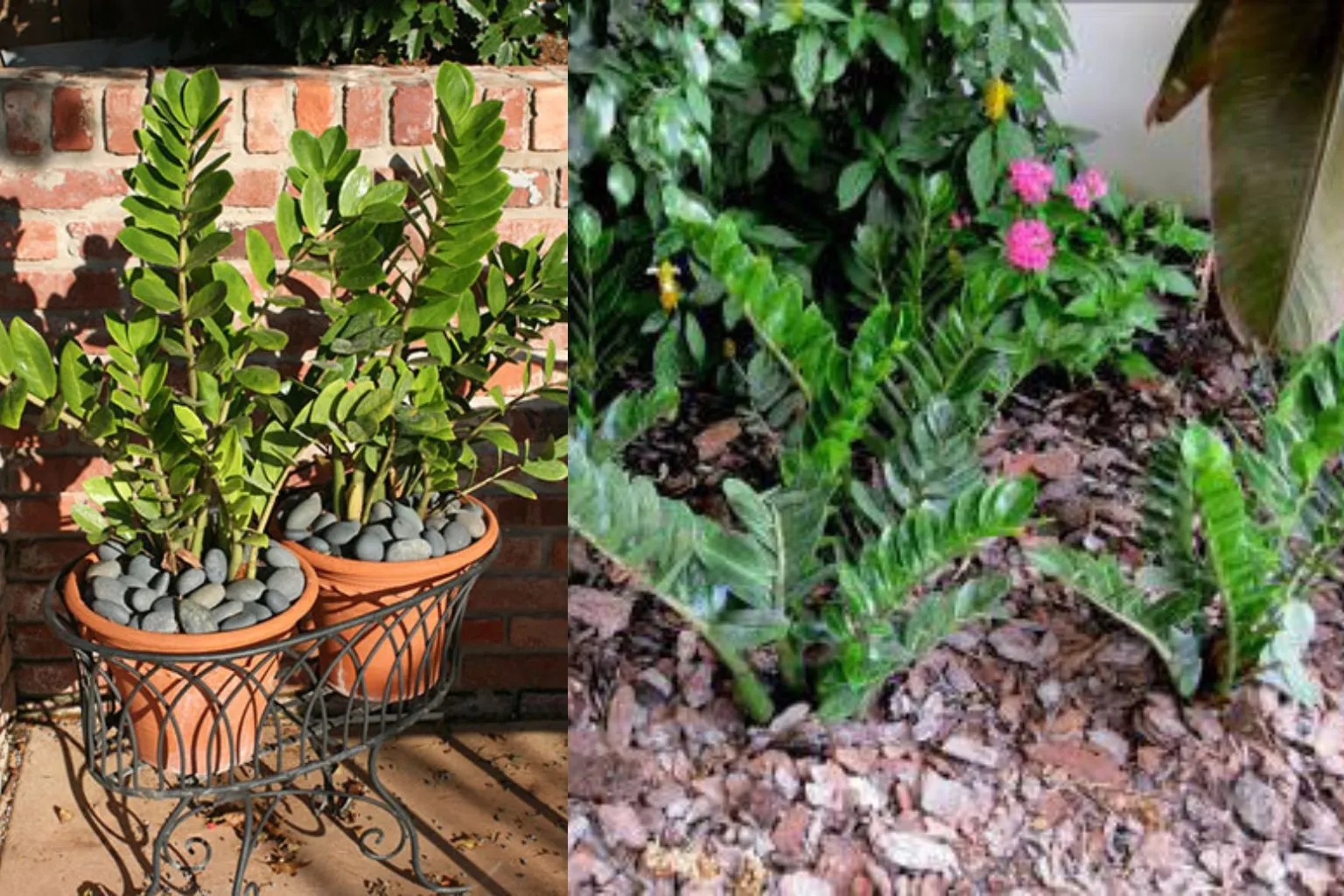The ZZ plant, scientifically known as Zamioculcas zamiifolia, has garnered significant attention among houseplant enthusiasts for its striking appearance and ease of care. Native to the arid regions of Eastern Africa, the ZZ plant thrives in environments where other plants might struggle, making it a resilient and adaptable choice for indoor gardening. Its glossy, dark green leaves grow in a feather-like pattern, adding a touch of elegance to any indoor space.
One of the standout features of the ZZ plant is its low-maintenance nature. Unlike many other houseplants, it requires minimal watering, can tolerate low light conditions, and is relatively pest-resistant. These characteristics make it an ideal plant for both novice and experienced gardeners, as well as for those with busy lifestyles who may not have the time to dedicate to plant care.
The popularity of ZZ plants can also be attributed to their air-purifying qualities. Studies have shown that ZZ plants can help remove toxins such as xylene, toluene, and benzene from the air, contributing to a healthier indoor environment. This functional benefit, combined with their aesthetic appeal, makes ZZ plants a favored choice for homes and offices alike.
Understanding the proper care for ZZ plants, particularly their temperature tolerance, is crucial for ensuring their health and longevity. While ZZ plants are known for their hardiness, they still require specific conditions to thrive. This guide aims to provide comprehensive information on the optimal temperature conditions for ZZ plants, helping you create an environment where your ZZ plant can flourish. By paying attention to the zz plant temperature tolerance, you can enjoy the beauty and benefits of this remarkable plant for years to come.

Ideal Temperature Range for ZZ Plants
The ZZ plant, or Zamioculcas zamiifolia, is renowned for its robust nature and adaptability to various indoor environments. For optimal growth and vibrant foliage, maintaining a temperature range between 65°F to 75°F (18°C to 24°C) is crucial. This range mimics the plant’s native tropical climate, providing conditions that support its physiological processes. Within this temperature window, the plant’s metabolic activities, such as photosynthesis and nutrient absorption, are most efficient, leading to healthier growth and a more aesthetically pleasing appearance.
When kept within the ideal temperature range, ZZ plants exhibit lush, glossy leaves and a steady growth rate. Temperatures consistently within this range help prevent the common issues associated with temperature stress, such as drooping leaves, yellowing, or stunted growth. Additionally, maintaining the recommended temperatures can reduce the risk of pest infestations and fungal diseases, which can be exacerbated by temperature fluctuations.
Although ZZ plants are known for their temperature tolerance, straying too far from the optimal range can have adverse effects. Prolonged exposure to temperatures below 60°F (15°C) can slow down their growth and make them susceptible to frost damage. On the other hand, temperatures above 80°F (27°C) can lead to excessive transpiration, causing the plant to lose moisture rapidly and potentially suffer from dehydration. Therefore, while ZZ plants can endure occasional deviations, consistently providing a stable environment within the 65°F to 75°F range is key to ensuring their long-term health and vitality.
In conclusion, adhering to the optimal temperature range for ZZ plants is an essential aspect of their care. By maintaining a stable environment between 65°F and 75°F, you can ensure that your ZZ plant remains healthy, vibrant, and resilient. This range not only supports the plant’s natural growth processes but also enhances its overall appearance, making it a delightful addition to any indoor space.
Impact of High Temperatures on ZZ Plants
ZZ plants, known for their resilience, can generally tolerate a broad range of temperatures. However, prolonged exposure to high temperatures, specifically above 85°F (29°C), can adversely affect their health. One of the primary signs of heat stress in ZZ plants is leaf yellowing. This symptom occurs as the plant’s internal water balance is disrupted, causing chlorophyll breakdown and subsequently, the yellowing of leaves.
In addition to leaf yellowing, wilting is another common indicator of heat stress. High temperatures increase the rate of transpiration, leading to excessive water loss. Consequently, the plant’s leaves may appear droopy and lack turgor, a clear sign that the plant is struggling to maintain adequate hydration. Furthermore, slowed growth can also be observed. Under extreme heat conditions, the ZZ plant may divert its energy from growth processes to survival mechanisms, resulting in stunted development.
To mitigate the adverse effects of high temperatures, several practical measures can be implemented. Firstly, providing shade is essential. Positioning the ZZ plant away from direct sunlight, especially during peak hours, can significantly reduce heat stress. Utilizing sheer curtains or placing the plant in a location with filtered light can also be beneficial.
Proper watering practices are equally important. During high-temperature periods, increasing the frequency of watering can help maintain the plant’s hydration levels. However, it is crucial to ensure that the soil remains well-drained to prevent root rot. Monitoring the soil moisture and watering when the top inch feels dry can be an effective approach.
Lastly, misting the plant with water can provide temporary relief from high temperatures. The evaporation of water from the leaves can create a cooling effect, helping to reduce the overall temperature stress experienced by the plant.
By understanding the zz plant temperature tolerance and implementing these practical strategies, you can ensure that your ZZ plant remains healthy and resilient, even in challenging high-temperature conditions.
Impact of Low Temperatures on ZZ Plants
ZZ plants, known for their resilience and low maintenance, can still be adversely affected by exposure to low temperatures. When temperatures drop below 50°F (10°C), ZZ plants begin to show signs of cold stress. One of the primary symptoms of this stress is the darkening of leaves, which may appear as a dull, almost blackish hue. This discoloration is often accompanied by a reduction in growth, as the plant’s metabolic processes slow down in response to the cold environment.
Another significant symptom of cold exposure is leaf drop. When the temperature remains consistently low, the plant may start shedding its leaves in an effort to conserve energy. The stems can also become soft and mushy, indicating potential damage to the plant’s internal structure. This can be particularly alarming as it suggests that the plant is struggling to maintain its health under the stress of cold temperatures.
To mitigate these issues, it is crucial to implement preventive measures. One effective strategy is to ensure that the ZZ plant is kept in a stable, warm environment away from drafts and cold windows. During colder months, relocating the plant to a warmer room or using a space heater to maintain a consistent temperature can be beneficial. Additionally, insulating the plant pot with a thermal cover or placing it on a heating mat can help maintain an optimal soil temperature, further protecting the roots from cold damage.
For plants that have already experienced cold stress, immediate action is necessary to minimize damage. Pruning away the affected leaves and stems can help the plant focus its energy on new growth. Providing adequate light and maintaining a consistent watering schedule will also support the plant’s recovery. By understanding the zz plant’s temperature tolerance and taking proactive steps, plant owners can ensure their ZZ plants remain healthy and vibrant even during colder periods.
ZZ Plant Temperature Tolerance
Understanding the temperature tolerance of ZZ plants is essential for their proper care and maintenance. ZZ plants, known scientifically as Zamioculcas zamiifolia, exhibit a remarkable ability to withstand a range of temperature conditions, making them an excellent choice for both indoor and outdoor settings. Typically, these resilient plants thrive in temperatures ranging from 65°F to 75°F (18°C to 24°C). However, they can endure short periods of temperature extremes beyond this optimal range.
During colder months, ZZ plants can tolerate temperatures as low as 45°F (7°C) for brief intervals. Nonetheless, prolonged exposure to such cold conditions can cause significant harm, leading to leaf yellowing, wilting, and even root damage. Conversely, in hotter climates, ZZ plants can survive temperatures up to 95°F (35°C) for limited durations. Extended exposure to high temperatures, however, may result in dehydration, leaf scorching, and stunted growth.
To ensure the well-being of ZZ plants, it is crucial to avoid sudden temperature fluctuations, which can induce shock and stress. Gradual acclimation to new temperature conditions is recommended to prevent adverse effects. For instance, when transitioning a ZZ plant from an indoor to an outdoor environment, it is advisable to initially place the plant in a shaded, protected area. Gradually increase its exposure to direct sunlight and varying temperatures over a week or more. This gradual adjustment helps the plant acclimate without undergoing undue stress.
Similarly, if moving a ZZ plant indoors from an outdoor setting, ensure that it is placed in a location with stable temperatures, away from drafts and direct heat sources such as radiators or heaters. Regular monitoring of the plant’s condition during these transitions is essential to identify and mitigate any signs of stress promptly.
In summary, while ZZ plants are adaptable to a range of temperatures, maintaining them within their preferred range and ensuring gradual acclimation to new conditions will foster their health and longevity. Adopting these guidelines will help ZZ plants thrive and continue to be a vibrant addition to any space.
Seasonal Temperature Care for ZZ Plants
When it comes to the care of ZZ plants, seasonal temperature variations play a crucial role in their overall well-being. Understanding the optimal conditions and adjusting care routines accordingly can make a significant difference in maintaining the health of your ZZ plant throughout the year.
During the summer months, ZZ plants thrive in temperatures ranging from 65°F to 75°F (18°C to 24°C). It’s important to avoid placing them in direct sunlight, as this can cause the leaves to scorch. Instead, opt for indirect light to ensure they receive adequate illumination without the risk of damage. Additionally, air conditioning should be used cautiously to prevent air from becoming too dry. ZZ plants prefer moderate humidity levels, so consider using a humidifier or placing a water tray nearby to maintain a balanced environment.
As winter approaches, ZZ plants can tolerate cooler temperatures, but it’s essential to keep them away from drafts and cold windows. Ideally, the temperature should not drop below 45°F (7°C). Indoor heating systems can create dry air conditions, which might stress the plant. To counteract this, regular misting or the use of a pebble tray with water can help maintain sufficient humidity levels. It’s also beneficial to ensure the plant receives adequate light, as shorter daylight hours can affect its growth. Supplementing natural light with artificial grow lights can be an effective solution during the darker months.
Seasonal adjustments are not solely about temperature but also about light and humidity. Balancing these factors harmoniously ensures that your ZZ plant remains robust and vibrant year-round. By understanding the zz plant temperature tolerance and its seasonal care requirements, you can effectively adapt your routine to provide the optimal conditions for your plant’s growth and longevity.
Indoor vs. Outdoor Temperature Considerations
When it comes to cultivating ZZ plants, understanding the nuances of indoor versus outdoor temperature considerations is paramount. This plant, known for its robust nature, exhibits a commendable degree of temperature tolerance, allowing it to thrive in various environments. However, both indoor and outdoor settings come with their unique benefits and risks.
Indoors, ZZ plants benefit from a controlled climate. Typical household temperatures, ranging between 65°F and 75°F (18°C – 24°C), are ideal for these plants. This range ensures stable growth and minimizes stress. Indoor cultivation also shields ZZ plants from sudden temperature fluctuations, which can be detrimental. However, it’s essential to avoid placing them near HVAC vents or drafty windows, as these can create inconsistent temperatures that might affect the plant’s health.
On the other hand, growing ZZ plants outdoors can be advantageous, especially in regions where the climate mimics their native environment. These plants can tolerate temperatures from 45°F to 85°F (7°C – 29°C). However, outdoor conditions pose risks, particularly during extreme weather changes. For instance, a sudden drop in temperature can cause significant damage. To mitigate this, consider bringing outdoor ZZ plants indoors during colder months or using frost cloths to protect them.
Moreover, outdoor ZZ plants might face challenges such as increased exposure to pests and direct sunlight, which can scorch their leaves. To combat this, placing the plant in a shaded area can help prevent overheating and sunburn. Regular monitoring and adjusting the plant’s location based on the season can also ensure optimal growth.
In essence, whether indoors or outdoors, the key to thriving ZZ plants lies in maintaining consistent and favorable temperatures. By understanding and adapting to the specific needs of your ZZ plant in each environment, you can ensure its health and longevity.
Advanced Tips for Managing ZZ Plant Temperature
For plant enthusiasts looking to optimize the temperature conditions for their ZZ plants, advanced strategies can make a significant difference in plant health and growth. One of the most effective tools is a reliable thermometer. By consistently monitoring the temperature around your ZZ plant, you can ensure it remains within the optimal range of 65-75°F (18-24°C). Sudden temperature fluctuations can be detrimental, so regular checks can preemptively address potential issues.
Humidity also plays a crucial role in maintaining the ideal environment for your ZZ plant. While ZZ plants are relatively tolerant of dry conditions, maintaining a moderate humidity level can promote healthier foliage. Using a humidifier can help maintain these conditions, especially during winter months when indoor air tends to be drier. Place the humidifier near your ZZ plant to create a microenvironment that mimics its natural habitat.
Fans can also be used strategically to manage air circulation around your ZZ plant. Proper airflow prevents the stagnation of air, which can lead to fungal issues and other plant diseases. A small oscillating fan set on a low setting can create a gentle breeze, enhancing air circulation without causing temperature drops that could stress the plant.
Creating microclimates within your home is another advanced technique to ensure your ZZ plant thrives. This can be achieved by grouping plants together, which naturally increases the local humidity levels through transpiration. Additionally, placing your ZZ plant in a location that avoids direct drafts from windows or doors can prevent exposure to sudden temperature changes.
Incorporating these advanced tips into your plant care routine will help you effectively manage the ZZ plant temperature tolerance. Regular monitoring and adjustments will enable you to provide a stable and conducive environment, ensuring your ZZ plant remains healthy and vibrant throughout the year.
Related FAQs:
What is the optimal temperature range for ZZ plants?
The ideal temperature range for ZZ plants is between 65°F and 75°F (18°C to 24°C). This range supports healthy growth and helps prevent issues like leaf yellowing and wilting.
Can ZZ plants tolerate cold temperatures?
ZZ plants can tolerate temperatures as low as 45°F (7°C) for brief periods. However, prolonged exposure to cold can cause leaf discoloration, leaf drop, and root damage.
How do high temperatures affect ZZ plants?
Temperatures above 85°F (29°C) can cause heat stress in ZZ plants, leading to yellowing leaves, wilting, and slowed growth due to excessive transpiration and dehydration.
What should I do if my ZZ plant is exposed to extreme temperatures?
If exposed to extreme cold, move your plant to a warmer area and prune any damaged leaves. For heat stress, provide shade, increase watering, and mist the plant to help it recover.
Can I keep my ZZ plant outside?
ZZ plants can be kept outside if temperatures remain within their tolerance range (45°F to 85°F or 7°C to 29°C). Bring them indoors or provide protection during extreme weather.
How can I protect my ZZ plant from temperature fluctuations?
Avoid placing your ZZ plant near drafts, heating vents, or air conditioning units. Gradually acclimate the plant to new environments and monitor the temperature regularly.
Do ZZ plants need special care during winter?
In winter, keep ZZ plants away from cold drafts and ensure temperatures do not drop below 45°F (7°C). Use a humidifier to maintain adequate humidity levels if indoor air is dry.
How can I maintain the ideal temperature for my ZZ plant?
Use a reliable thermometer to monitor the temperature around your plant. Adjust your home’s heating or cooling systems as needed and use fans or humidifiers to create a stable environment.
Conclusion:
Understanding and managing the temperature requirements of your ZZ plant is crucial for its health and vitality. Native to the arid regions of Eastern Africa, ZZ plants thrive in temperatures between 65°F and 75°F (18°C to 24°C). Adhering to this range prevents issues like leaf yellowing, wilting, and stunted growth.
Advanced care tips, such as using thermometers, humidifiers, and fans, help maintain an optimal environment. These tools allow you to create a stable microclimate, enhancing your plant’s natural growth processes. Whether indoors or outdoors, avoiding sudden temperature fluctuations and providing adequate light and hydration are essential for your ZZ plant’s success.
Beyond their aesthetic appeal, ZZ plants offer air-purifying benefits, removing toxins like xylene, toluene, and benzene from the air. This makes them an excellent choice for improving indoor air quality.
Incorporating ZZ plants into your home or office adds natural beauty and promotes a healthier environment. By following the guidelines outlined in this guide, you can ensure that your ZZ plant remains healthy, robust, and attractive for years to come. With the right conditions and a little care, your ZZ plant will thrive, bringing greenery and tranquility to your space.

